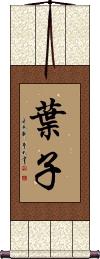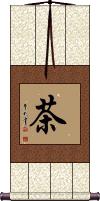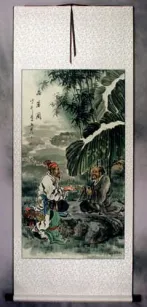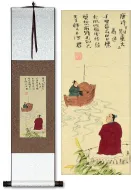Many custom options...
And formats...

Leaves in Chinese / Japanese...
Buy a Leaves calligraphy wall scroll here!
Personalize your custom “Leaves” project by clicking the button next to your favorite “Leaves” title below...
Red Leaves of Autumn
Hiding in the Leaves - Hagakure
Leaf
茶 means tea. It can refer to prepared tea (ready-to-drink) or dry tea leaves.
The origin of tea is China but the same character is used in Japanese Kanji, and old Korean Hanja with the exact same meaning. Japanese and Korean even borrowed the pronunciation from Chinese (pronounced “cha” in all three languages).
It's said that an early doctor (or herbologist) in ancient China kept poisoning himself as he tried different new herb concoctions. He invented tea as a means to detoxify himself as he recovered from 1 of the 76 times he nearly poisoned himself to death. Tea is seen not just as a drink but as a form of medicine used to remove impurities from the body.
The word “chai” (used in many languages to refer to various teas) is derived from this Chinese word.
茶 also means camellia, as Asian teas are often based on the leaves of camellia plant varieties.
This in-stock artwork might be what you are looking for, and ships right away...
Gallery Price: $304.00
Your Price: $168.88
Gallery Price: $300.00
Your Price: $195.88
Gallery Price: $300.00
Your Price: $195.88
Gallery Price: $300.00
Your Price: $195.88
These search terms might be related to Leaves:
Cao / Kusa / Grass
Even Monkeys Fall From Trees
Not the results for leaves that you were looking for?
Below are some entries from our dictionary that may match your leaves search...
| Characters If shown, 2nd row is Simp. Chinese |
Pronunciation Romanization |
Simple Dictionary Definition |
茶 see styles |
chá cha2 ch`a cha cha ちゃ |
More info & calligraphy: Tea(1) (See お茶・1) tea; (2) tea plant (Camellia sinensis); (3) (See 茶道) tea preparation; making tea; (4) (abbreviation) (See 茶色) brown; (noun or adjectival noun) (5) (archaism) (See 茶化す) mockery; (surname, given name) Cha Tea; tea-leaves; translit. ja, jha. |
葉 叶 see styles |
yè ye4 yeh you / yo よう |
More info & calligraphy: Yeh(suf,ctr) (1) counter for leaves, pieces of paper, etc.; (suf,ctr) (2) (archaism) counter for boats; (female given name) Yō; (surname) Yō; Ye pattra; parṇa; leaf, leaves. |
謝 谢 see styles |
xiè xie4 hsieh ja じゃ |
More info & calligraphy: Shea(surname) Ja To thank; return (with thanks), decline; fall; apologize; accept with thanks. |
紅葉 红叶 see styles |
hóng yè hong2 ye4 hung yeh kouyou / koyo こうよう |
More info & calligraphy: Red Leaves of Autumn(n,vs,vi) (See 黄葉) leaves turning red (in autumn); red leaves; autumn colours; fall colors; (female given name) Moyo |
貝文 贝文 see styles |
bèi wén bei4 wen2 pei wen haimon |
More info & calligraphy: Bevon |
葉隠れ see styles |
hagakure はがくれ |
More info & calligraphy: Hiding in the Leaves - Hagakure |
梖 see styles |
bèi bei4 pei bai |
pattra; 梖多葉 the palm-leaves used for writing; the梖多樹 is erroneously said to be the borassus flabelliformis, described as 60 or 70 feet high, not deciduous, the bark used for writing. |
箊 see styles |
yū yu1 yü |
bamboo with thin; wide leaves |
粽 see styles |
zòng zong4 tsung chimaki ちまき |
rice dumplings wrapped in leaves cake wrapped in bamboo leaves; (surname) Chimaki |
線 线 see styles |
xiàn xian4 hsien sen せん |
thread; string; wire; line; CL:條|条[tiao2],股[gu3],根[gen1]; (after a number) tier (unofficial ranking of a Chinese city) (n,n-suf) (1) line; stripe; stria; (n,n-suf) (2) line (e.g. telephone line); wire; (n,n-suf) (3) (See X線) ray (e.g. X-ray); beam; (n,n-suf) (4) line (e.g. of a railroad); track; route; lane; (n,n-suf) (5) outline; contours; form; (n,n-suf) (6) level; (n,n-suf) (7) division; (n,n-suf) (8) (See いい線) line (of action); position; approach; policy; principle; (n,n-suf) (9) (See 線が太い,線が細い) impression one leaves; air one gives off; (surname) Sen A thread, wire, clue, spy, lead, connection. |
苴 see styles |
jū ju1 chü kaishiki かいしき |
(hemp); sack cloth leaf, branch with leaves, or paper placed under a serving dish or offering |
茗 see styles |
míng ming2 ming mei / me めい |
Thea sinensis; young leaves of tea (See 茶・ちゃ・1) tea (esp. picked late); (female given name) Mei |
菰 see styles |
gū gu1 ku komo こも |
Manchurian wild rice (Zizania latifolia), now rare in the wild, formerly harvested for its grain, now mainly cultivated for its edible stem known as 茭白筍|茭白笋[jiao1bai2sun3], which is swollen by a smut fungus; (variant of 菇[gu1]) mushroom (1) (abbreviation) woven straw mat (orig. made of wild rice leaves); (2) beggar; (3) (archaism) Manchurian wild rice (Zizania latifolia) |
菸 烟 see styles |
yū yu1 yü |
to wither; dried leaves; faded; withered |
落 see styles |
luò luo4 lo raku らく |
to fall or drop; (of the sun) to set; (of a tide) to go out; to lower; to decline or sink; to lag or fall behind; to fall onto; to rest with; to get or receive; to write down; whereabouts; settlement (irregular okurigana usage) (1) slip; omission; (2) outcome; final result; the end; (3) (kana only) punch line (of a joke); (surname) Raku Falling leaves: to fall, drop, descend, settle; translit. la, na. |
蒅 see styles |
sukumo すくも |
dye made of fermented indigo leaves |
蕸 see styles |
xiá xia2 hsia |
water-lily leaves |
薦 荐 see styles |
jiàn jian4 chien susumu すすむ |
to recommend; to offer sacrifice (arch.); grass; straw mat (1) (abbreviation) woven straw mat (orig. made of wild rice leaves); (2) beggar; (3) (archaism) Manchurian wild rice (Zizania latifolia); (given name) Susumu |
蘀 萚 see styles |
tuò tuo4 t`o to |
fallen leaves and bark |
丁数 see styles |
chousuu / chosu ちょうすう |
(1) number of leaves (in a book, esp. one with traditional Japanese-style binding); number of sheets; (2) (See 偶数) even number |
万緑 see styles |
banryoku ばんりょく |
myriad green leaves |
万葉 see styles |
manyou; mannyou / manyo; mannyo まんよう; まんにょう |
(1) (abbreviation) (See 万葉集) Man'yōshū (8th century anthology of Japanese poetry); (2) (archaism) thousands of leaves; (3) (archaism) thousands of years; all ages; eternity; (female given name) Mitsuyo |
三塗 三涂 see styles |
sān tú san1 tu2 san t`u san tu sanzu |
The 塗 mire is interpreted by 途 a road, i.e. the three unhappy gati or ways; (a) 火塗 to the fires of hell; (b) 血塗 to the hell of blood, where as animals they devour each other; (c) 刀塗 the asipattra hell of swords, where the leaves and grasses are sharp-edged swords. Cf. 三惡趣. |
下葉 see styles |
shitaba したば |
(ant: 上葉・うわば) lower leaves |
乾葉 干叶 see styles |
gān yè gan1 ye4 kan yeh hiba ひば |
dried leaf dried leaves; dried daikon leaves |
內胎 内胎 see styles |
nèi tāi nei4 tai1 nei t`ai nei tai naitai |
inner tube (of a tire) The inner garbhadhātu, i. e. the eight objects in the eight leaves in the central group of the maṇḍala. |
切頭 see styles |
settou / setto せっとう |
(1) cutting off the head; (2) shaping the flowers and leaves of a plant |
剪る see styles |
kiru きる |
(Godan verb with "ru" ending) to cut; to prune; to trim (branches, leaves, flowers, etc.) |
卵形 see styles |
luǎn xíng luan3 xing2 luan hsing rankei / ranke らんけい tamagogata たまごがた |
oval; egg-shaped (leaves in botany) (noun - becomes adjective with の) oval; egg-shaped |
口茶 see styles |
kuchija くちぢゃ |
adding more tea; adding fresh leaves to used ones in a teapot |
Click here for more leaves results from our dictionary
The following table may be helpful for those studying Chinese or Japanese...
| Title | Characters | Romaji (Romanized Japanese) | Various forms of Romanized Chinese | |
| Red Leaves of Autumn | 紅葉 红叶 | moyo | hóng yè / hong2 ye4 / hong ye / hongye | hung yeh / hungyeh |
| Hiding in the Leaves - Hagakure | 葉隠れ | hagakure | ||
| Leaf | 葉子 叶子 | kyouko / kyoko | yè zi / ye4 zi / ye zi / yezi | yeh tzu / yehtzu |
| Tea | 茶 | cha | chá / cha2 / cha | ch`a / cha |
| In some entries above you will see that characters have different versions above and below a line. In these cases, the characters above the line are Traditional Chinese, while the ones below are Simplified Chinese. | ||||
Successful Chinese Character and Japanese Kanji calligraphy searches within the last few hours...













